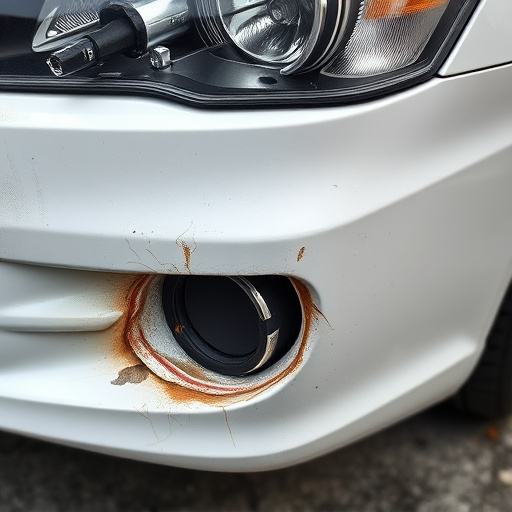Revolutionizing Auto Repairs with Waterborne Paint Systems

Waterborne paint systems are revolutionizing auto repair with their environmental benefits and super…….
Welcome to an in-depth exploration of waterborne paint systems, a revolutionary approach to the coatings industry that has transformed various sectors globally. This article aims to demystify the complex world of waterborne paints, shedding light on its history, applications, and immense potential. By the end, readers will grasp why these systems have become a game-changer in manufacturing, construction, automotive, and beyond. We’ll navigate through its development, impact, and future trajectory, offering valuable insights for professionals and enthusiasts alike.
Waterborne paint systems, as the name suggests, are advanced coating technologies that utilize water as a primary solvent instead of traditional organic solvents like toluene or xylene. This innovative approach offers a cleaner, safer, and more environmentally friendly alternative for applying pigments and binders to various substrates. The system typically comprises:
Pigments: These are the colored particles suspended in the paint, providing aesthetic appeal and protection from light and weathering. Common pigment types include iron oxides, titanium dioxide, and organic dyes.
Binders: Act as a glue, holding the pigments together and adhering them to the substrate. Water-soluble binders, such as polyurethanes or acrylics, ensure smooth film formation upon drying.
Water: Serves as the primary solvent, enabling easy application, fast drying, and minimal environmental impact.
The concept of waterborne paints dates back to the late 19th century when early forms emerged for industrial applications. However, it was in the mid-20th century that advancements in chemistry and technology led to their widespread adoption, offering improved performance, reduced odour, and better handling properties compared to traditional oil-based paints.
The influence of waterborne paint systems is a global phenomenon, with diverse regions adopting this technology for its numerous advantages. Key trends shaping the market include:
Environmental Concerns: Increasing awareness of environmental degradation has driven demand for low-VOC (Volatile Organic Compound) and water-based alternatives. Many countries have implemented strict emission standards, pushing manufacturers to transition to waterborne systems.
Health and Safety: Waterborne paints eliminate harmful fumes, making them safer for applicators and end-users. This is particularly beneficial in enclosed spaces and indoor environments.
Cost Efficiency: These systems offer cost-effective solutions, especially for large-scale projects. Lower material and application costs have made waterborne paints an attractive option for many industries.
Regional Analysis:
| Region | Market Growth (2021-2028) | Key Drivers | Challenges |
|---|---|---|---|
| North America | 5.2% | Strict environmental regulations, robust construction sector | High competition, price fluctuations |
| Europe | 6.7% | Increasing focus on sustainable products, favorable government incentives | Post-Brexit trade disruptions, varying regional standards |
| Asia-Pacific | 8.4% | Rapid urbanization, growing automotive industry | Supply chain constraints, varying local regulations |
| Latin America | 4.1% | Expanding infrastructure projects, rising disposable income | Limited product availability, technical knowledge gap |
| Middle East & Africa | 7.3% | Large-scale construction projects, favorable government initiatives | High temperatures, limited local manufacturing |
The waterborne paint systems market is a dynamic sector, influenced by global economic factors and regional trends. Key aspects include:
Market Size: According to a 2022 report by Grand View Research, the global waterborne paints market size was valued at USD 47.3 billion in 2021 and is expected to grow at a CAGR of 5.6% from 2022 to 2030.
Investment Patterns: The industry attracts significant investments from both established paint manufacturers and new entrants, driven by the pursuit of sustainable and high-performance products.
Economic Benefits: These systems contribute to economic growth by reducing material and application costs for businesses. They also support green initiatives, leading to potential tax incentives and positive brand perception.
The evolution of waterborne paint technology has been marked by numerous innovations, each pushing the boundaries of performance and sustainability. Notable advancements include:
Low-VOC Formulations: Continuous efforts to reduce VOC content have led to ultra-low or zero-VOC waterborne paints, ensuring minimal odor and improved air quality during application.
Quick-Drying Polymers: Researchers have developed advanced binders that dramatically reduce drying times, enabling faster project completion and increased productivity on construction sites.
Bio-based Pigments: The use of bio-derived pigments, such as those from plant extracts, offers a sustainable alternative to traditional mineral pigments, further enhancing the eco-friendly profile of waterborne paints.
Digital Application Techniques: The introduction of advanced application technologies, like airless spraying and robotic painting, ensures precise and efficient coating, minimizing waste and improving overall performance.
The waterborne paint industry operates within a framework of environmental, health, and safety regulations, ensuring responsible manufacturing and use. Key policy aspects include:
Air Quality Standards: Many countries have implemented strict guidelines on VOC emissions, prompting manufacturers to reformulate paints to meet these standards.
RoHS (Restriction of Hazardous Substances): This European Union directive restricts the use of certain hazardous substances in electrical and electronic equipment, influencing the composition of waterborne paints used in electronics assembly.
REACH (Registration, Evaluation, Authorization, and Restriction of Chemicals): A European regulation that requires manufacturers to register, evaluate, authorize, and restrict the use of chemicals, ensuring safe and sustainable practices in paint production.
Local Variations: Different regions have unique regulations, such as specific labeling requirements or restrictions on hazardous substances, which manufacturers must adhere to for global market access.
Despite its numerous advantages, the waterborne paint systems industry faces several challenges that require strategic solutions:
Cost vs. Performance: While waterborne paints offer cost benefits, some users perceive them as less performant than traditional oil-based systems, especially in specific applications like marine or industrial coatings. Addressing this through improved formulations and education can change these perceptions.
Drying Time Concerns: Despite advancements, quick-drying properties can be a challenge in certain conditions, such as low temperatures or high humidity. Continued research into faster-drying technologies is crucial.
Availability of Raw Materials: The availability and cost of raw materials, particularly bio-based alternatives, can impact production and pricing. Diversifying supply chains and exploring sustainable sources are potential solutions.
Regulatory Compliance: Staying ahead of evolving regulations, especially in a global market, presents a significant challenge for manufacturers. Investing in research and development to ensure compliance is essential.
The success of waterborne paint systems can be best demonstrated through real-world applications. Here are two notable case studies:
Case Study 1: Green Building Revolution in Scandinavia
A leading Scandinavian construction company adopted waterborne paints for their eco-friendly building projects. By using low-VOC, bio-based waterborne systems, they achieved significant reductions in indoor air pollution and lowered their carbon footprint. The fast drying time of the paint enabled faster project completion, resulting in cost savings and improved customer satisfaction.
Case Study 2: Sustainable Automotive Finish in Japan
A Japanese automotive manufacturer transitioned to waterborne paints for their vehicle body finishes, aiming for a more sustainable production process. The new system reduced VOC emissions by 70% compared to traditional solvent-based paints. Improved color consistency and chip resistance further enhanced the quality of the final product, gaining market recognition for the company’s environmental commitment.
The waterborne paint systems industry is poised for continued growth and innovation, driven by several emerging trends and strategic considerations:
Sustainability at the Forefront: The push for sustainable products will remain a primary focus, with manufacturers exploring new bio-based materials and further reducing VOC content.
Digital Transformation: Digital technologies, such as AI and IoT (Internet of Things), will revolutionize paint formulation and application processes, enabling precision and automation.
Specialty Paints Gaining Traction: Customized waterborne paints tailored for specific industries, like aerospace or electronics, will see increased demand due to their enhanced performance requirements.
Global Expansion: Emerging markets in Asia and Africa present significant growth opportunities as these regions undergo rapid industrialization and urbanization.
Waterborne paint systems have emerged as a transformative force in the coatings industry, offering unparalleled environmental benefits, improved health and safety, and enhanced performance. From construction to automotive and beyond, its impact is undeniable. As we look ahead, the future of waterborne paints appears bright, with continuous technological advancements, growing global awareness, and a commitment to sustainability driving the industry forward.
Q: Are waterborne paints suitable for outdoor applications?
A: Absolutely! Waterborne systems have excellent weather resistance and durability, making them ideal for exterior painting projects, including buildings, bridges, and marine coatings.
Q: Do waterborne paints offer the same level of protection as traditional oil-based paints?
A: While they may require additional coats in certain harsh environments, waterborne paints provide robust protection against corrosion and weathering. Their low VOC content also ensures better air quality during application.
Q: Can waterborne paint systems be used for artistic or decorative painting?
A: Certainly! Waterborne acrylics, in particular, are popular among artists for their vibrant colors, fast drying time, and versatility. They can be used on various surfaces, including canvas, wood, and paper.
Q: How do I choose the right waterborne paint for my project?
A: Consider factors like substrate type, desired finish, environmental conditions, and specific performance requirements. Consult with paint manufacturers or professionals to determine the best product for your needs.
Q: Are there any health risks associated with using waterborne paints?
A: When used correctly, waterborne paints pose minimal health risks. However, as with any paint, proper ventilation is essential during application to avoid inhaling vapors. Always follow safety guidelines and use personal protective equipment (PPE).

Waterborne paint systems are revolutionizing auto repair with their environmental benefits and super…….

Waterborne paint systems are favored in automotive restoration for their eco-friendliness and perfor…….

Waterborne paint systems have gained popularity for their eco-friendly design and reduced volatile o…….

Waterborne paint systems, eco-friendly and safe alternatives to VOC-based paints, have gained popula…….

Waterborne paint systems are becoming popular in automotive repairs due to their environmental benef…….

Waterborne paint systems are gaining popularity due to their environmental friendliness and user saf…….

Waterborne paint systems have gained popularity for their eco-friendliness and superior performance…….

Waterborne paint systems are transforming automotive repair and restoration with their eco-friendly…….

Waterborne paint systems, using water as a solvent, offer environmental and performance benefits ove…….

Waterborne paint systems, though often misunderstood, offer environmental and health benefits with e…….